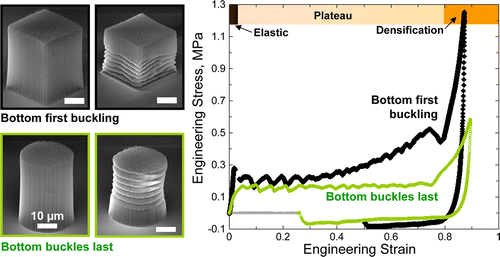
Year
2013Volume
7Issue
10Pages
8593–8604Abstract
Micromechanical experiments, image analysis, and theoretical modeling revealed that local failure events and compressive stresses of vertically aligned carbon nanotubes (VACNTs) were uniquely linked to relative density gradients. Edge detection analysis of systematically obtained scanning electron micrographs was used to quantify a microstructural figure-of-merit related to relative local density along VACNT heights. Sequential bottom-to-top buckling and hardening in stress–strain response were observed in samples with smaller relative density at the bottom. When density gradient was insubstantial or reversed, bottom regions always buckled last, and a flat stress plateau was obtained. These findings were consistent with predictions of a 2D material model based on a viscoplastic solid with plastic non-normality and a hardening–softening–hardening plastic flow relation. The hardening slope in compression generated by the model was directly related to the stiffness gradient along the sample height, and hence to the local relative density. These results demonstrate that a microstructural figure-of-merit, the effective relative density, can be used to quantify and predict the mechanical response.






